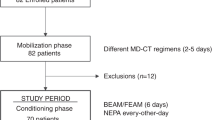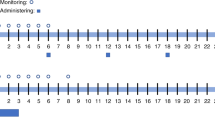Abstract
Interpatient variability in exposure to certain chemotherapy agents can influence patient outcome, particularly with high-dose chemotherapy. We evaluated the possibility of a pharmacokinetic (PK) drug–drug interaction between the antiemetic agents and high- dose cyclophosphamide, cisplatin and BCNU (CPA/cDDP/BCNU). Twenty-three self-selected patients treated with high-dose CPA/cDDP/BCNU followed by autologous hematopoietic progenitor cell support (AHPCS) received ondansetron, lorazepam and diphenhydramine as antiemetics. PK parameters for each chemotherapeutic drug in the regimen were compared with those of 129 patients who received exactly the same chemotherapy but an antiemetic regimen substituting prochlorperazine for ondansetron. In addition, we performed a review of the English literature for reported drug–drug interactions between antiemetics and chemotherapy agents that led to modifications in any PK parameters of the chemotherapy agent. Our retrospective study showed that the mean area under the curve (AUC) for both cyclophosphamide (76 600 vs90 600 μg/ml/min, P = 0.001) and cisplatin (525 vs 648 μg/ml/min, P = 0.01) were significantly lower in the ondansetron group when compared with the prochlorperazine group. The AUC for BCNU was not significantly different in both groups (544 vs 677, P = 0.43). We found only one report of modifications of the PK parameters of high-dose chemotherapy agents due to drug–drug interactions with the most commonly used antiemetics in a review of the English literature between 1966 and 1995. We concluded that the AUC of high-dose cyclophosphamide and cisplatin are significantly lower when ondansetron, as opposed to prochlorperazine, is used as the antiemetic. The small sample size and heterogeneity of this group of patients precludes any outcome analysis of pharmacodynamic endpoints such as toxicity or antitumor effect. Nevertheless, the potential for interactions between antiemetics and chemotherapy agents should be taken into account when using different high-dose chemotherapy regimens.
This is a preview of subscription content, access via your institution
Access options
Subscribe to this journal
Receive 12 print issues and online access
$259.00 per year
only $21.58 per issue
Buy this article
- Purchase on Springer Link
- Instant access to full article PDF
Prices may be subject to local taxes which are calculated during checkout
Similar content being viewed by others
Author information
Authors and Affiliations
Rights and permissions
About this article
Cite this article
Cagnoni, P., Matthes, S., Day, T. et al. Modification of the pharmacokinetics of high-dose cyclophosphamide and cisplatin by antiemetics. Bone Marrow Transplant 24, 1–4 (1999). https://doi.org/10.1038/sj.bmt.1701832
Received:
Accepted:
Published:
Issue Date:
DOI: https://doi.org/10.1038/sj.bmt.1701832
Keywords
This article is cited by
-
Prevalence and significance of potential drug-drug interactions among cancer patients receiving chemotherapy
BMC Cancer (2020)
-
Pharmacoepidemiological study of drug–drug interactions in onco-hematological pediatric patients
International Journal of Clinical Pharmacy (2014)
-
Pharmacokinetic interaction between tamoxifen and ondansetron in rats: non-competitive (hepatic) and competitive (intestinal) inhibition of tamoxifen metabolism by ondansetron via CYP2D subfamily and 3A1/2
Cancer Chemotherapy and Pharmacology (2010)
-
Drug interactions in cancer therapy
Nature Reviews Cancer (2006)
-
Pharmacokinetics of high-dose chemotherapy
Bone Marrow Transplantation (2004)



